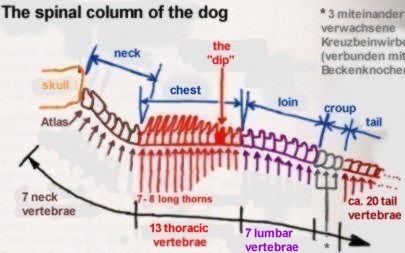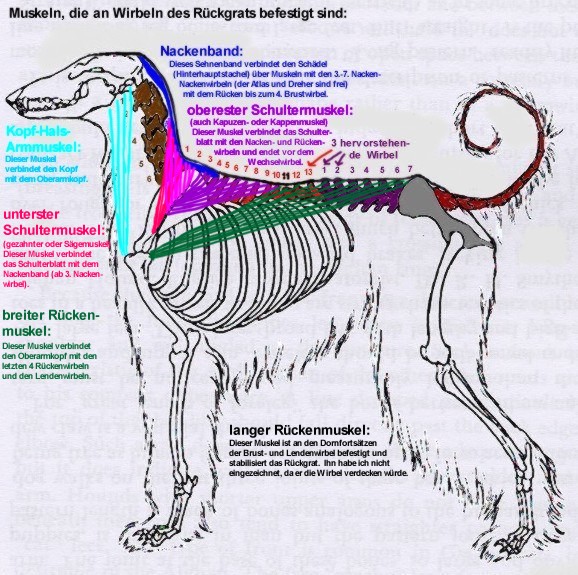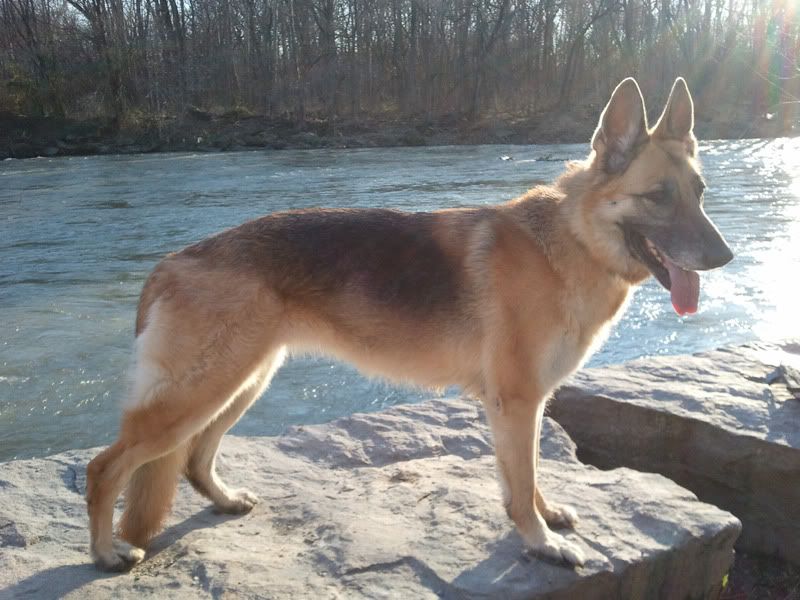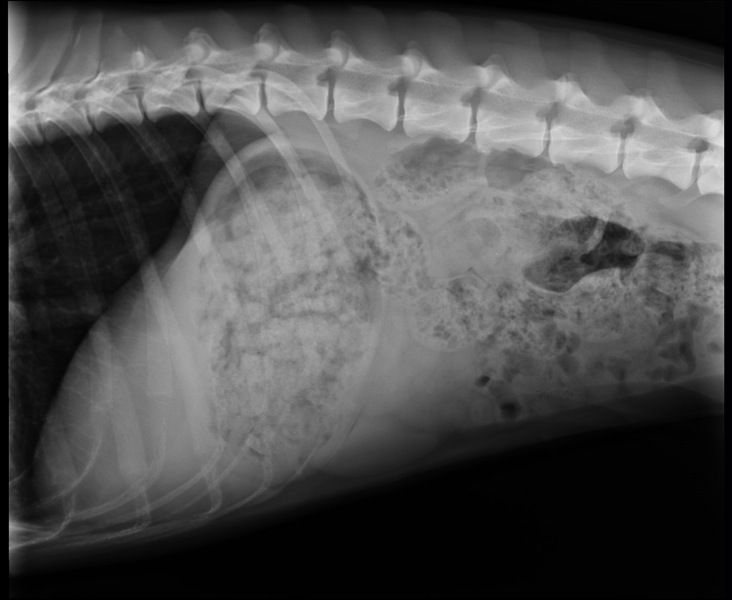I was watching Canine Training System's "GSD- The German Way" when they started talking about the top line. I found the analysis very interesting and thought I'd share some of it with you all. Most interesting is that I have xrays of Pimg for various reasons, and I was able to look at her spine to compare to what they were saying.
I wanted to bring to point the anticlinal vertebra, T11, often referred to (apparently) as "the dip." I found this particular vertebra interesting because Carmen happened to comment about it in Pimg's critique thread. What I learned in the video is that the tall spikes on the spine are positioned the way they are for a reason. In this illustration, you can see that the thoracic vertebrae (above the rib cage) all point backwards, and each one more so than the last.
![Image]()
These points (called the dorsal spinous process) are positioned like this because muscles attach to the processes and go forward to the scapula. See the picture below to understand how the muscles attach:
![Image]()
The laid back angle of the process creates a stronger attachment point to withstand the force from the muscle contraction. This is the same thought when anchoring in a tug-o-war competition. One needs to remain low and angled back. As soon as you stand vertical, all of your strength is compromised and a team loss is inevitable. Want to win in tug-o-war? Stay low and leaning back. Want to have a strong thoracic dorsal spinous process? Make sure it is angled back.
![Image]()
That's all interesting... but what the heck does it have to do with "The Dip?" Well- just like the thoracic vertebrae's dorsal spinous processes are leaning backward, the lumbar vertebrae's (loin section) dorsal spinous processes are leaning forward. While some muscles going to the front of the dog do attach to these processes, the muscles that pull the rear legs forward also attach here. And for the same reason that the thoracic dorsal processes lean back, the lumbar dorsal processes need to lean forward providing strength for the muscles hooking to the rear legs. It turns out that T11, or the anticlinal vertebra, or "The Dip" is the transitional vertebra where the backwards and forward leaning dorsal processes meet.
It should be noted that the taller the dorsal processes in the thoracic section of the dog, the more the dip will be hidden. Also, the more heavily muscled the dog's back, the more hidden this transition will be.
So finally with all of this crazy info, I can take a look at the photo of Pimg stacked that I used in her critique thread:
![Image]()
Seeing "the dip" provides some good info about her top line conformation. What I can now see is that the dorsal processes in her thoracic vertebrae are short. This is apparent from her flat withers and confirmed via the xray below which, by the way, clearly shows the T11 vertebra:
![Image]()
It is now clear to me that when I see a smooth topline in the dog, there are a couple things going on. First, that the dorsal processes in the thoracic vertebrae are tall. This is important not because the angle of the withers is desirable aesthetically, but because the taller process means that the muscle has that much more leverage. This is exactly the reason we want to see an angle in the withers, because it means the muscles attached to the scapula can be that much more efficient. And secondly, it means that the dog has decent muscling in the back- at least enough to hide the T11 transition that will be there. The design of the dog dictates a transitional vertebra; not seeing the transition is a sign of strong muscling, which of course is desirable for the longevity of the back joints.
And I guess the contrapositive is also true. When we see "the dip" like in Pimg, we can know there is a potential for weak muscling in the back, and also potential for short dorsal processes meaning an inefficiency in the muscling contracting the scapula. I find this fascinating and it will help me more appreciate a smooth top line!
I wanted to bring to point the anticlinal vertebra, T11, often referred to (apparently) as "the dip." I found this particular vertebra interesting because Carmen happened to comment about it in Pimg's critique thread. What I learned in the video is that the tall spikes on the spine are positioned the way they are for a reason. In this illustration, you can see that the thoracic vertebrae (above the rib cage) all point backwards, and each one more so than the last.

These points (called the dorsal spinous process) are positioned like this because muscles attach to the processes and go forward to the scapula. See the picture below to understand how the muscles attach:

The laid back angle of the process creates a stronger attachment point to withstand the force from the muscle contraction. This is the same thought when anchoring in a tug-o-war competition. One needs to remain low and angled back. As soon as you stand vertical, all of your strength is compromised and a team loss is inevitable. Want to win in tug-o-war? Stay low and leaning back. Want to have a strong thoracic dorsal spinous process? Make sure it is angled back.

That's all interesting... but what the heck does it have to do with "The Dip?" Well- just like the thoracic vertebrae's dorsal spinous processes are leaning backward, the lumbar vertebrae's (loin section) dorsal spinous processes are leaning forward. While some muscles going to the front of the dog do attach to these processes, the muscles that pull the rear legs forward also attach here. And for the same reason that the thoracic dorsal processes lean back, the lumbar dorsal processes need to lean forward providing strength for the muscles hooking to the rear legs. It turns out that T11, or the anticlinal vertebra, or "The Dip" is the transitional vertebra where the backwards and forward leaning dorsal processes meet.
It should be noted that the taller the dorsal processes in the thoracic section of the dog, the more the dip will be hidden. Also, the more heavily muscled the dog's back, the more hidden this transition will be.
So finally with all of this crazy info, I can take a look at the photo of Pimg stacked that I used in her critique thread:

Seeing "the dip" provides some good info about her top line conformation. What I can now see is that the dorsal processes in her thoracic vertebrae are short. This is apparent from her flat withers and confirmed via the xray below which, by the way, clearly shows the T11 vertebra:

It is now clear to me that when I see a smooth topline in the dog, there are a couple things going on. First, that the dorsal processes in the thoracic vertebrae are tall. This is important not because the angle of the withers is desirable aesthetically, but because the taller process means that the muscle has that much more leverage. This is exactly the reason we want to see an angle in the withers, because it means the muscles attached to the scapula can be that much more efficient. And secondly, it means that the dog has decent muscling in the back- at least enough to hide the T11 transition that will be there. The design of the dog dictates a transitional vertebra; not seeing the transition is a sign of strong muscling, which of course is desirable for the longevity of the back joints.
And I guess the contrapositive is also true. When we see "the dip" like in Pimg, we can know there is a potential for weak muscling in the back, and also potential for short dorsal processes meaning an inefficiency in the muscling contracting the scapula. I find this fascinating and it will help me more appreciate a smooth top line!




